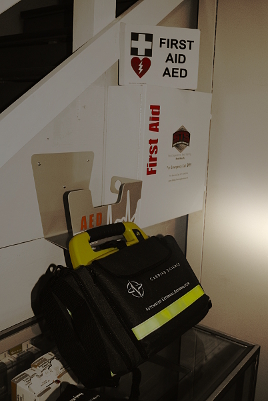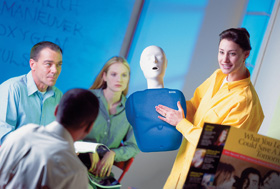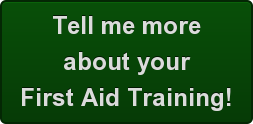February is American Heart Month and this year, I wanted to not only bring up awareness of issues surrounding this, but also discuss how to be proactive and how to react to these situations, as some can come abrupt and with little to no warning.
The American Heart Month tradition began in 1964. In a Proclamation by Lyndon B. Johnson, he stated that "it is essential to the health and well-being of our nation that our citizens be made aware of the medical, social, and economic aspects of the problem of cardiovascular diseases, and the measure being taken to combat them."
"I urge the people of the United States to give heed to the nationwide problem of the heart and blood vessel diseases, and to support the programs required to bring about its solution."
In an interest to follow this tradition, I will first and foremost discuss heart attacks and sudden cardiac arrest, as well as decipher the differences between them. As I stated earlier, in addition to bringing up awareness of the two, we will also discuss the symptoms, signs, and how to help others during an incident involving these heart problems.
cardiac arrest, as well as decipher the differences between them. As I stated earlier, in addition to bringing up awareness of the two, we will also discuss the symptoms, signs, and how to help others during an incident involving these heart problems.
Well, the difference between a heart attack and sudden cardiac arrest begins with the human circulatory system. As you are surely aware, the heart pumps oxygen-rich blood to the body via electrical impulses from the brain. This knowledge helps to understand this difference; a heart attack is when the flow of blood to the heart is blocked and sudden cardiac arrest is when the heart stops beating unexpectedly.
Heart Attack - Circulation Problem
Sudden Cardiac Arrest - Electrical Problem
Sudden cardiac arrest and heart attack are, in fact, linked. A heart attack can lead into sudden cardiac arrest, as heart attacks are a common cause. Other heart conditions can also lead to sudden cardiac arrest, including cardiomyopathy or ventricular fibrillation. Remember, time is of the essence, and fast responses mean better survival rates. Knowing the signs and symptoms of these heart issues will help be proactive and ready if and when you find yourself in one of these situations.
Generally, heart attack symptoms start slowly and can gradually continue for hours, days, even weeks, but can also (with less frequency) be both immediate and intense. The heart usually does not stop beating during a heart attack.
-
Chest pain
-
Radiating pain
-
Difficulty breathing
-
Stomach pain, nausea, dizziness, cold sweats
-
(These are more common in women, but can occur in men as well)
 If you are in a situation in which someone around you is experiencing what you believe to be a heart attack, you have about five minutes to call 911 (or other local emergency response number). This is because every minute is important for a heart attack victim. Having emergency services show with an ambulance is one of the best ways to handle the situation, the emergency responders and can give treatment as soon as they arrive, and treatment can continue in the ambulance rather than if you drove them to the hospital yourself.
If you are in a situation in which someone around you is experiencing what you believe to be a heart attack, you have about five minutes to call 911 (or other local emergency response number). This is because every minute is important for a heart attack victim. Having emergency services show with an ambulance is one of the best ways to handle the situation, the emergency responders and can give treatment as soon as they arrive, and treatment can continue in the ambulance rather than if you drove them to the hospital yourself.
As opposed to the generally gradual continuance of heart attack symptoms, sudden cardiac arrest occurs suddenly and often without warning. As I stated earlier, this is an electrical malfunction in the heart which causes irregular heartbeats. This malfunction causes the heart to cease pumping blood to the main organs (brain, lungs, etc.). Within seconds, a person can lose their pulse and consciousness. Again, time is of the upmost importance, as there is only a two minute window to treat the victim before death can (and most likely will) occur.
-
Sudden loss of responsiveness
-
No response to tapping on shoulders
-
Does nothing when you ask if they're ok
-
No normal breathing
If you experience these (above) signs in a potential cardiac arrest victim,
1. You must first shout for help and have them call 911 (or your local emergency response number).
2. Have said help grab you an automated external defibrillator (AED)(if one is available).
3. Check breathing; give CPR if necessary.
4. Use AED as soon as it arrives (turn it on and follow the prompts).
5. Follow the prompts for CPR & AED usage until an emergency responder or more advanced help arrives.
The good news is that sudden cardiac arrest is reversible in most cases. If it is treated within a
few minutes with CPR and an AED, the survival rate of the victim increases exponentially.
- Sudden cardiac arrest is a leading cause of death in the United States, claiming more than 350,000 lives each year.
- An estimated 382,800 people experience sudden cardiac arrest in the United States each year.
- Approximately 92% of those who experience sudden cardiac arrest do not survive.
- It is estimated that 95% of victims who experience sudden cardiac arrest die before they reach a hospital or some other source of emergency help.
- If a sudden cardiac arrest victim receives defibrillation through an AED within the first minute, the survival rate is 90%.
- For every minute that passes without defibrillation, survival decreases by 7-10%.
- 30-50% of sudden cardiac arrest victims would survive if AEDs were used within five minutes.
- If defibrillation is delayed more than ten minutes, the survival rate is less than 5%.
It is easy to see how important it is to have ready access to an AED. It is essentially a necessity as a proactive solution to these unexpected heart issues. There are plenty of places to get your hands on an AED and some training to supplement it. Safety Training Services is a one stop shop for AED training, sales and rentals.

 As stated by OSHA, first aid is emergency care provided for injury or sudden illness before emergency medical treatment is available. The first aid provider in the workplace is someone who is trained in the delivery of initial medical emergency procedures, using a limited amount of equipment to perform a primary assessment and intervention while awaiting arrival of emergency medical services (EMS) personnel.
As stated by OSHA, first aid is emergency care provided for injury or sudden illness before emergency medical treatment is available. The first aid provider in the workplace is someone who is trained in the delivery of initial medical emergency procedures, using a limited amount of equipment to perform a primary assessment and intervention while awaiting arrival of emergency medical services (EMS) personnel. fatalities. That same year had 4.3 million total workplace injuries and illnesses, with 1.3 million resulting in days away from work.
fatalities. That same year had 4.3 million total workplace injuries and illnesses, with 1.3 million resulting in days away from work.
 "Hands-on," skill based teaching methods.
"Hands-on," skill based teaching methods.